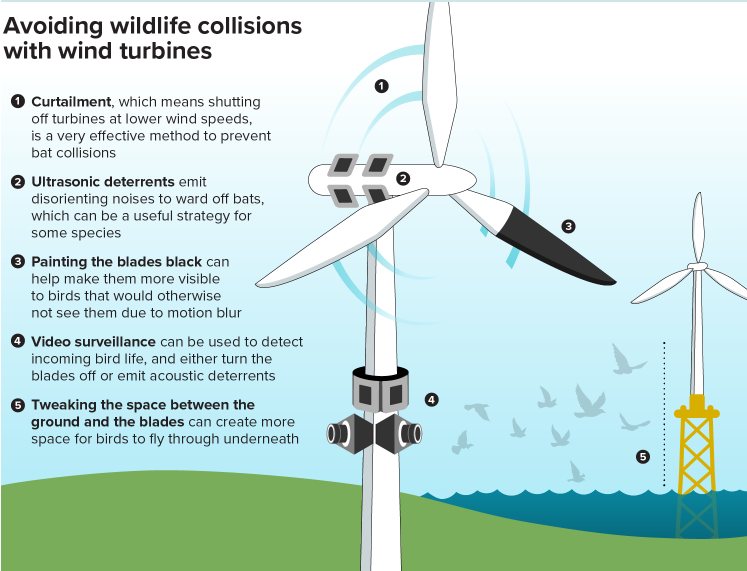Facts for UPSC Mains
Wind Energy Expansion and Biodiversity Conservation
- 06 Aug 2025
- 6 min read
Why in News?
India's rapid expansion of wind energy, reaching 51.3 GW by mid-2025, has raised concerns about its environmental impact, particularly on bird populations.
- A study by the Wildlife Institute of India (WII) highlighted high bird mortality at wind farms in the Thar Desert, home to critically endangered species.
- Additionally, as India expands offshore wind energy, concerns grow over impacts on marine biodiversity and inadequate environmental assessments.
What are the Concerns Regarding Wind Turbines' Impact on Avian Populations and Offshore Wind Energy?
Wind Turbines and Avian Populations
- High Bird Deaths Documented: The WII study in the Thar Desert found 124 bird carcasses near 90 wind turbines, estimating 4,464 bird deaths per 1,000 sq. km annually.
- Great Indian Bustard and Raptors (Birds of prey), are most affected due to their soaring flight and low reproduction rates, making them highly vulnerable to wind turbine collisions.
- The Thar Desert, part of the Central Asian Flyway, sees significant migratory bird traffic, adding to the vulnerability.
- Power Lines: The study also accounted for bird deaths from collisions with power lines connected to wind farms, compounding the issue, which were not factored into earlier studies.
- Lack of Environmental Oversight: Onshore wind farms are not required to conduct Environmental Impact Assessments (EIAs) in India, leading to projects being set up in ecologically sensitive zones without proper study.
Offshore Wind Energy Exploration
- Threat to Marine Biodiversity: Offshore wind farms can disturb marine habitats, especially sensitive breeding grounds for fish, turtles, and marine mammals.
- Installation activities like piling and dredging generate underwater noise, affecting echolocation and navigation of species like dolphins and whales.
- Maintenance of turbines and supporting vessels carries the risk of fuel and lubricant spills, potentially harming marine life.
- Offshore wind projects lack comprehensive studies on their impact on marine ecosystems. While offshore projects require EIAs, many reports are rapid and may overlook critical ecological factors.
- The rapid EIA for the Gulf of Khambhat offshore wind farm noted dolphins, sharks, and a reptile in the area, downplaying operational impacts.
- Technological and Logistical Challenges: India currently lacks domestic expertise and proven technology for deep-water installations. Harsh marine conditions can affect turbine durability and maintenance schedules.
How Can India Balance Wind Energy Development with Biodiversity Conservation??
- Site Selection: Use tools like Avian Sensitivity Tool for Energy Planning (AVISTEP) (an open-source tool by Birdlife International) to identify areas with minimal bird impact.
- AVISTEP categorizes India into avian sensitivity levels—‘low’, ‘moderate’, ‘high’, and ‘very high’ but ground-level studies are essential before installing wind farms.
- Zoning and Spatial Planning of Renewable Projects: Identify and map “no-go” zones for renewable energy infrastructure using long-term field data, satellite tracking, and conservation research.
- Establish designated power corridors to avoid fragmented infrastructure across GIB habitats.
- The Supreme Court-appointed Expert Committee has recommended demarcating priority, and potential conservation areas for targeted protection.
- Support Conservation Breeding and Species Revival: Implement the “jump-start” method by incubating late-stage eggs of GIB from Rajasthan and transferring the chicks to safe places to rebuild local populations.
- Technological Solutions: Painting one turbine blade to increase visibility and prevent bird strikes, along with implementing shutdown strategies during migration periods, are key mitigation measures.
- EIA Mandates: Require EIAs for all onshore wind farms to assess ecological risks.
- Integration of Wind, Solar, and BESS Systems: Combining Wind with Solar and Storage: India should focus on integrating wind energy with solar power and battery energy storage systems (BESS) to ensure round-the-clock power supply and grid stability.
- Monitoring & Research: Conduct surveys and long-term studies to track wind energy’s impact on wildlife, especially in sensitive areas like the Thar Desert.
Wind Power
- As of June 2025, Wind energy contributed 21.78% to India's total renewable energy generation.
- As per International Renewable Energy Agency (IRENA) Renewable Energy Statistics 2025, India ranks 4th globally in Wind Power.
- India's wind energy capacity has surged from approx. 21 GW in 2014 to 51.3 GW by June 2025, more than doubling in a decade.
- According to the National Institute of Wind Energy, India has a massive wind potential of 1164 GW at 150 meters above ground level, highlighting the vast untapped resources for further growth in the wind energy sector.
|
Drishti Mains Question: “India’s rapid wind energy expansion has come at an ecological cost.” Discuss. |







